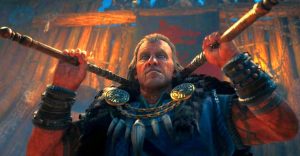Why D&D’s Vistani Are Still Problematic [UPDATED]

[UPDATE 16:00 02/08/2021: The following article has been modified to more clearly define the Vistani in Dungeons & Dragons.]
Wizards of the Coast, the publisher of Dungeons & Dragons, has received criticism over the years regarding some of the content in their sourcebooks, and one of the more recent criticisms is the portrayal of the fantasy group the Vistani in the 2016 adventure module Curse of Strahd. In response to the backlash, Wizards of the Coast retconned and re-released the handbook with amendments to the depiction of the Vistani, but it’s not certain that it did enough to ease the racial stereotyping.
The Vistani are a thinly veiled fantasy analogue to the Romani (Roma) people, a marginalized group residing in Europe and West Asia. The Roma, often labeled by the pejorative term ‘gypsy’, were subject to the ethnic cleansing put forth by the Nazi Party during the Holocaust. The original D&D 5E Curse of Strahd campaign depicted the Vistani as wanderers who wore scarves and bangles, traveling in covered wagons known as “vardos” (which closely resemble the real-life Romani vardo wagons), telling fortunes, and reading Tarokka Cards. They were also put forth as drunks, liars, cheats, baby thieves, and dark magicians who used an Evil Eye to place hexes on people – typical of stereotypes utilized to ostracize the Romani people throughout real-world history.
In an effort to make the TTRPG more inclusive, Wizards of the Coast pulled the original Curse of Strahd campaign from shelves and re-released the revised version in 2020 with the aid of a Romani consultant. Unlike the previous version of the module where the Vistani were exclusively depicted with either a neutral or evil alignment, they were now presented with having an equal propensity to all alignments as others did. They also neutralized their terminology when it came to the Vistani culture, no longer labelling them as drunken reprobates or uncivilized. Chris Perkins, D&D’s principal narrative designer, on the changes told IGN, “We wanted to clean that up a bit and remove some stuff that the fans didn’t particularly like in terms of representation and how they were depicted – it’s that sort of very granular-but-important change. More like surgical changes to the adventure than some sort of grand sweeping change.”
Why Changes to The Vistani Did Little to Fix Problematic Depiction

Some fans and critics of the roleplaying game alike have agreed that the changes made by Wizards of the Coast are not enough to expunge the harm imposed by the stereotypes. There was no redaction on the Vistani’s propensity for their dark, mysterious powers, or use of the Evil Eye which was a persistent prejudice used against the Romani people. Their physical designs also still closely match the harmful stereotype of the wandering charlatan pushed in Gothic and British literature. There was altogether little effort made to divorce the concept of the Vistani from the real-world people upon which they’d been based.
While Wizards of the Coast has publicly stated on its blog that efforts on diversity and inclusion are an explicit goal of fifth edition Dungeons & Dragons, the company still has a long way to go with improving its past history of problematic designs. The Vistani push a harmful stereotype analogous to the Romani people, and despite efforts to amend that, the issue still persists.
Sources: IGN, Wizards of the Coast
About The Author

















